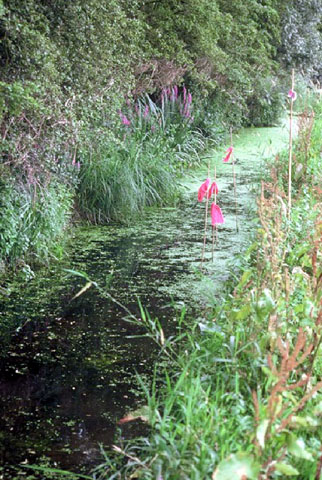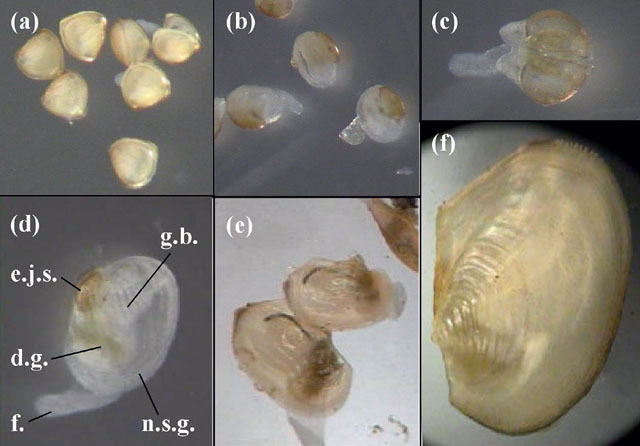

by
Anna McIvor, Cambridge University, the 2004 Annual Award Winner
Freshwater mussels (Bivalvia: Unionidae) are filter feeders, removing phytoplankton and other suspended particulate matter from the water. This removal of suspended matter from the water is often considered desirable, in order to reduce phytoplankton blooms and in the treatment of drinking water. My thesis investigated the potential role of freshwater mussels as living filters, or 'biofilters', in a variety of settings.
Initial measurements of the filtration rates of British freshwater mussels showed that individual mussels could filter up to half a litre of water per hour. Calculations of the filtration rates of mussel populations in four British rivers indicated that mussel filtering can remove between 7% and 30% of the particulate matter in a parcel of water as it travels 10km downstream. This implies that mussels play an important role in the removal of suspended particulate matter in river ecosystems.

The ditch on the Ouse Washes in which mussels reduced the floating macrophyte cover. The section of ditch containing mussels had submerged macrophytes and no floating macrophytes (front-left). Where the mussel stretch ended (marked by bamboo canes), floating macrophyte cover began (mainly Lemna spp.). The dense cover visible further along the ditch was typical of many of the ditches on the Ouse Washes.
In a large-scale experiment on the Ouse Washes RSPB nature reserve, mussels were placed in three eutrophic ditches to assess their potential use in the biomanipulation of these ditches. Although mussels suffered high mortality in two ditches, in the third ditch 70% of mussels survived, and the section of ditch containing mussels remained clear of floating macrophytes throughout the summer (as shown in Figure 1). However the mussels had little measurable effect on the water quality in the ditches, and further work is needed before their use in future biomanipulations.
The novel use of mussels in drinking water treatment was investigated by placing mussels in large flow-through tanks at Coppermills drinking water treatment works (operated by Thames Water). Mussels reduced the concentration of chlorophyll a and suspended solids in the water flowing through tanks, and increased sedimentation through the production of faeces and pseudofaeces. Therefore mussels behaved as flocculators, and have potential for use in the early stages of drinking water treatment in small water treatment plants.
In order to assess the feasibility of producing the large numbers of mussels needed for their use as biofilters, freshwater mussels were cultured in the laboratory. Juveniles of Anodonta anatina and A. cygnea were successfully reared for over a year, and reached 14mm in length (mean = 11.3mm, n = 17) with 20% survival (Figure 2). Unio pictorum and Pseudanodonta complanata were also reared for 274 and 100 days respectively, although they had lower survival and growth.

Figure 2. Anodonta spp. juvenile mussels aged 0 to 382 days old: (a) newly excysted juveniles with foot, lengths approximately 330 m; (b) and (c) 9-day-old juveniles showing variable shell growths, lengths 340 to 540 μm; (c) preferred orientation of juveniles for moving; (d) 40-day-old juveniles, showing early juvenile shell (e.j.s), new shell growth (n.s.g.), digestive gland (d.g.), gill bars (g.b.), and foot (f.), shell length 930 μm; (e) 120-day old juveniles, with the digestive gland and gut clearly visible, lengths 3.1 and 4.0 mm; (f) 382-day-old A. cygnea, length 12 mm.
The apparatus used in these rearing attempts was small and inexpensive, and could be scaled up to produce the required number of mussels for their use as biofilters. Additionally, the rearing of P. complanata is important for the conservation of this rare mussel species, and offers the first opportunity to study its juvenile morphology and habitat requirements.
The value of mussels in freshwater ecosystems
As biofilters, mussels provide an important ecosystem service, removing phytoplankton and suspended particulate matter from the water. Recognition of the filtering services provided by mussels is a first step towards an economic valuation of their contribution to the healthy functioning of freshwater ecosystems. This is important because the value of inland water bodies for providing drinking water, waste removal, flood prevention, navigation and recreation is very high; relative to this the aesthetic value of the biotic components of these ecosystems will be low (and is as yet unquantified). Consequently, river management practices are generally unsympathetic to the river biota, and are at least partially responsible for the decline in freshwater mussels (alongside the effects of pollution and invasive bivalve species). If the river biota, including mussels, can be shown to increase the monetary value of a water body by affecting the provision of drinking water and recreation, then river managers will be encouraged to include the biota in their planning of river management.
Future work
While working on this thesis I became increasingly interested in the use of ecosystem services as a means of bringing river biota into the realm of economics, so that their conservation should not remain a matter of academic and aesthetic interest only. I intend to continue this work by doing an economic valuation of the filtering services provided by freshwater mussels in rivers. I then hope to broaden my valuation to include other parts of river ecosystems, and to link these together in a spatial model covering a whole catchment. This could subsequently be used to compare the costs and benefits of different river management strategies, in order to test the hypothesis that 'biota-friendly' management will be cost-effective because it makes use of the free ecosystem services provided by organisms such as freshwater mussels.